
An employee arranges a digital price tag for vegetables at the Whole Foods store in the Silver Lake neighborhood of Los Angeles.
Patrick T. Fallon/Bloomberg via Getty Images
Grocery store prices are changing faster than ever before — literally. This month, Walmart became the latest retailer to announce it’s replacing the price stickers in its aisles with electronic shelf labels. The new labels allow employees to change prices as often as every ten seconds.
“If it’s hot outside, we can raise the price of water and ice cream. If there's something that’s close to the expiration date, we can lower the price — that’s the good news,” said Phil Lempert, a grocery industry analyst.
Apps like Uber already use surge pricing, in which higher demand leads to higher prices in real time. Companies across industries have caused controversy with talk of implementing surge pricing, with fast-food restaurant Wendy’s making headlines most recently. Electronic shelf labels allow the same strategy to be applied at grocery stores, but are not the only reason why retailers may make the switch.
The ability to easily change prices wasn’t mentioned in Walmart’s announcement that 2,300 stores will have the digitized shelf labels by 2026. Daniela Boscan, who participated in Walmart’s pilot of the labels in Texas, said the label’s key benefits are “increased productivity and reduced walking time,” plus quicker restocking of shelves.
Walmart’s not the first major grocer to make the change, as you can already find electronic shelf labels at Whole Foods, Amazon Fresh stores, and the Midwestern chain Schnucks. Digitized shelf labels are even more common in stores across Europe.
Another feature of electronic shelf labels is their product descriptions. Lempert notes that barcodes on the new labels can provide useful details other than the price.
“They can actually be used where you take your mobile device and you scan it and it can give you more information about the product — whether it’s the sourcing of the product, whether it’s gluten free, whether it’s keto friendly. That’s really the promise of what these shelf tags can do,” Lempert said.
As higher wages make labor more expensive, retailers big and small can benefit from the increased productivity that digitized shelf labels enable, said Santiago Gallino, a professor specializing in retail management at the University of Pennsylvania's Wharton School.
“The bottom line, at least when I talk to retailers, is the calculation of the amount of labor that they’re going to save by incorporating this. And in that sense, I don’t think that this is something that only large corporations like Walmart or Target can benefit from," Gallino said. "I think that smaller chains can also see the potential benefit of it."
While the labels give retailers the ability to increase prices suddenly, Gallino doubts companies like Walmart will take advantage of the technology in that way.
“To be honest, I don’t think that’s the underlying main driver of this,” Gallino said. “These are companies that tend to have a long-term relationship with their customers and I think the risk of frustrating them could be too risky, so I would be surprised if they try to do that.”
Rather than seeing an opportunity to use surge pricing, Gallino says retailers are likely drawn to electronic shelf tags to ensure consistency between online and in-store pricing.
“Today, Walmart customers can check on their app once they’re in the store, the prices that Walmart is offering online,” he said. “And if there are discrepancies, this can bring frustration or make the customers get confused.”
Electronic shelf tags should make it much easier for brick-and-mortar stores to keep pace with prices as they change online. And, he says, that consistency should be better for customers.
Article Link
Archive

